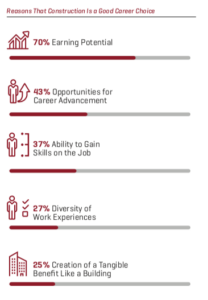The Commercial Construction Index shows trends in the construction industry. One trend that has been tracked over the past few years is the construction labor shortage, but it has not yet explored one of the main reasons behind this shortage, the many misconceptions of working in construction. Listen to “A Podcast That Builds” host Ben Johnson and Dodge’s Donna Laquidara-Carr discuss the findings from the 2019 Q1 CCI Report, including insights into working in construction, and how contractors can find construction labor during the construction labor shortage. Below is a transcript of this construction podcast.

Ben Johnson:
Hello and welcome to “A Podcast That Builds”, where today we have our seasoned guest, Donna Laquidara-Carr, here to discuss the Q1 CCI, Commercial Construction Index, report spotlight article. Welcome, Donna.
Donna Laquidara-Carr:
Thank you. That’s nice to be here. Again,
Ben Johnson:
Great to have you. As always. So quickly, let’s first remind our listeners what the CCI is.
Donna Laquidara-Carr:
Well, every quarter we survey GC’s and trade contractors for the US Chamber of Commerce and USG. And we ask them how they feel about their businesses. We create the index by asking them about three things in particular, their revenue, their backlog and their confidence in being able to secure new business. But we also survey them on other issues of every quarter and things that impact the index, things like their profit margins, their ability to access financing and of course their concerns about labor shortages. And then finally every quarter we ask about a unique topic or trend the just to kind of see how the industry’s evolving, take that opportunity to as to speak to the contractors about what’s really going on. And this quarter what we chose to talk about is working in construction. Things about what makes construction careers appealing, how are they perceived out in the larger world and how to find construction labor.
Ben Johnson:
So, what, what made you choose this topic in particular?
Donna Laquidara-Carr:
Well, we knew we wanted to look at the issue of recruiting. We’ve been looking at the construction labor shortage for a while. They’ve been pretty serious. And the idea of recruiting seemed like a good thing to address given that so that’s how we started. And then where do you start with that issue? What we thought, why not ask people working in construction what they like about their jobs?
Ben Johnson:
So, what did you learn about why contractors do like their jobs?
Donna Laquidara-Carr:
Well, what we learned is that they really liked the fact that they think the earning potential in construction is strong. That was selected by 70% of them as one of their top three reasons. We also see almost half looking for opportunities for career advancement. They really feel like there’s a path for them to move forward in their companies. So, 43% say that’s a really valuable part of their career. And we see more than a third, about 37% talk about the ability to gain skills on their job is something that they really value.
Ben Johnson:
So, I’m just curious, were there any differences between the responses from GC’s versus trades?
Donna Laquidara-Carr:
Well some the trade contractors really put a great deal of emphasis on earning potential and they also, although it figured a little bit lower, it didn’t make the top three, they also put a lot more emphasis on the opportunity to work with advanced technologies than did the general contractors. On the other hand, general contractors really view the ability to work collaboratively as a leading benefit, far more than the trade contractors did. So, you know, they, they really do focus on different, more, you know, the trade contractors are more technical. The GC’s really see that, that working with other companies as a key factor.
Ben Johnson:
So, do you think that people outside the construction industry understand that working in construction has some of these benefits?
Donna Laquidara-Carr:
Well, I’ll tell you one thing. The survey pretty much revealed that the contractors don’t think that they do. And I think that they’re probably right about that. Certainly, the contractors found that most people think that you can’t support a family on construction pay despite the fact that earning potential is their number one category for a what really makes their jobs valuable. Also, while contractors see gaining skills as an important part of their work, they think that most people view construction either as a dirty job or that it just requires brute strength rather than training. So, this, you know, that those two are major disconnects in terms of how they see their jobs themselves and what they think the general population views.
Ben Johnson:
Yeah. So, you said you were looking at this from the perspective of recruitment. What are the, the implications about how to draw people into the industry given these facts?
Donna Laquidara-Carr:
Well, you know, it’s really important to work against those preconceptions about working in construction. Do you really need to figure out a way to get the word out on what it truly is like to work in this field? And you know, they have to think about how to target those messages to specific groups you want to recruit. And we actually thought about that when we came up with the questions in this survey. So one of the things we asked about is specifically what would help attract more workers under 30 and over half said it’s, you know, higher paying good benefits, you know, and that’s pretty much any career where you can get those would be considered valuable by someone, you know, relatively new to the workforce. But over 40% felt that that clear path of advancement. And remember that was one of the top findings that that needs to be better understood by, you know, those under 30 to bring them into the workforce.
And then they really did think that the work itself should be part of, of what it takes to recruit those under 30, you see over a third, about 34% who believed that the satisfaction derived from a career that’s involved in actually making something, you know, having this building or this infrastructure element that’s available at the end. That would really appeal to a younger generation. And then finally, I think it’s worth pointing out that a full 32% thought that promoting the use of technology on job sites, advanced technology, things like construction drones, sensors is an important part of the messaging for that younger generation even though they themselves scored it much lower when they said what they were excited about when they work on the jobs.
Ben Johnson:
Yeah. And that, that all makes sense. But were there any, any surprising findings that emerged from this?
Donna Laquidara-Carr:
Yeah, I was a bit surprised that there’s no standardization at all for how they go about recruiting workers. Now we know at Dodge that construction is often a pretty fragmented industry, so it probably shouldn’t have been as much of a surprise as it was, but to learn that fewer than half use any of the means that we included in the survey to recruit workers, anything from traditional advertisements to working with industry organizations or educational institutions. That really did actually very much surprise me. And interestingly enough, this particular question, you know, we often ask when we ask them to, to select what they do, we’ll often include another, where they can specify some things that we might’ve missed. But this particular question did have a few people chime in on that other field where they said, the one thing we didn’t ask about, and that I think is important in the industry, given the fact that several people mentioned it, was that they were recruiting through word of mouth.
But this is not exactly the most structured way to recruit, especially during the construction labor shortage. So, you know, we’ve, I think the contractors really face the challenge. You know, they’ve got to get their work done and recruiting is not, you know, it’s a secondary task. It’s usually assigned to someone who’s wearing four different hats, especially at smaller companies. Right. So, you know, it’s not actually that surprising when you take a step back and look at it that there’s no consistent way that recruiting is going on in the industry. But you know, as we see things changing as we see the workforce aging and retiring and you know, they’re going to have a really big problem and they need to tackle this issue of recruiting. And I don’t know if you know, that means getting to hire third party companies or if that means getting support from industry associations, but it’s something that really the construction industry should start to look at.
Ben Johnson:
So that is definitely a challenge upcoming for the entire industry. So did the survey results yield any, any recommendations about how to find construction labor or how to recruit more effectively?
Donna Laquidara-Carr:
Well, you know, the contractors really looked at getting the word out about higher pay and path of advancement. You know, it wasn’t just for younger workers. They really felt that that in general would, would draw more people in. One area that was interesting is that they also put a great deal of emphasis on having more apprenticeship programs and the percentage who thought that they should have more apprenticeship programs. It was a lot higher than those who actually offer apprenticeship programs. So that’s another area that the industry probably should be looking at.
Ben Johnson:
So, do you have any, any final thoughts on the whole issue of recruitment in the industry?
Donna Laquidara-Carr:
Well, we’ve heard a lot from the industry about trying to recruit from new groups, right? You see a lot of coverage in the press about them trying to recruit women, recruit veterans, minorities, younger people. However, we’ve also learned that the, none of you know that very few of the contractors are actually recruiting through veterans’ associations or have programs in place specifically designed to recruit women. Now when you take a step back again and look at the fact that they don’t have any kind of really structured recruitment going on, it’s not surprising that even more specialized recruitment is pretty rare. But for construction going forward, I think we’re going to have to figure out how to tap into resources that will allow us to expand that pool of potential workers and figure out the question of how to find construction labor.
Ben Johnson:
So that’s a fascinating topic. Do we know what is up next for the second quarter of 2019?
Donna Laquidara-Carr:
Yes. We definitely know that we’re going to look at sustainability. We’re still kind of working out exactly what details are going to be included in it, but we know it’s going to include some trending data and now this will be our third year looking at that topic so we could have some very interesting trending data there. And again, we are exploring some new areas to kind of prove at, so that one should be an interesting one.
Ben Johnson:
Oh, looking forward to talking about it here. Thanks again, Donna.
Donna Laquidara-Carr:
Right. Thank you.
Ben Johnson:
A link to the report referenced in today’s show, the 2019 Q1 CCI Report is in the show notes and it’s also available at construction.com – click on Resources and you’ll find it there. If your firm could use custom market research similar to that we covered in today’s show, or if you need project intelligence for construction projects across North America, you can reach Dodge at construction.com or at (877) 784-9556. Thanks again for listening. We’ll see you next time.
Episode Links:

